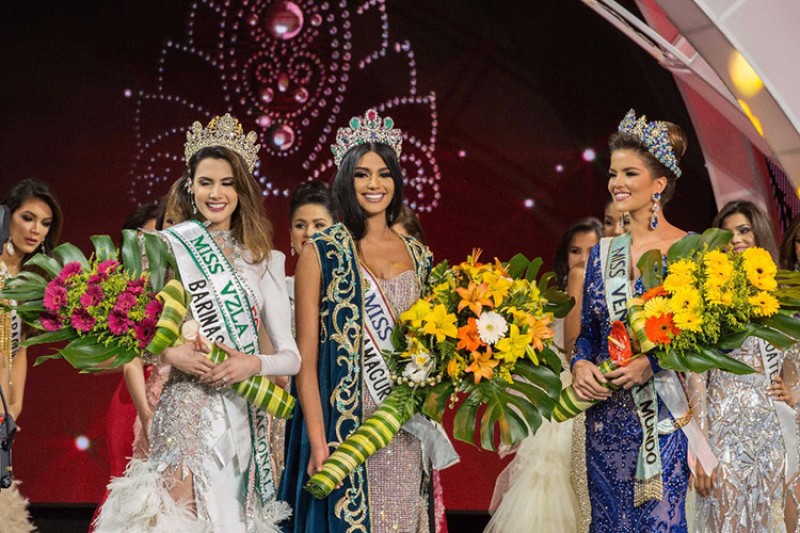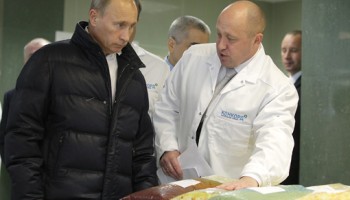In Venezuela, few things are certain.
In one of the most violent countries on Earth, no one knows for sure whether they will make it home alive on any given day or whether they will find enough food and medicine to survive. Nonetheless, one institution continues to dazzle in sequins and stand on stilettos as proud and tall as the Andes: Miss Venezuela.
On the night it happens, the pageant paralyzes cities and floods social media. The Austrian crystals, Japanese mother-of-pearl, and Russian zircons of the winner’s crown shimmer in children’s dreams. Like the pageant or hate it, you will certainly hear about it -- at least the parts caught on camera.
Since its debut in 1952, the spectacle has become a part of Venezuela’s national identity. “Missology” is practically an academic discipline: There are pageant savants, doctoral theses, endless arguments over winners and losers, and web pages and blogs that discuss the pageant’s smallest details.
But for some contenders, what happens out of camera range is more dispiriting than fairy tale. Grinding poverty and the demand to reach supernatural standards of beauty prompt some young contenders to seek the help of “saints” -- wealthy and powerful patrons willing to buy the clothes, gym access, and plastic surgery needed to create the illusion of “perfect” beauty.
As Venezuela spirals into chaos, critics say that more and more aspiring beauty queens are making such deals, making for downbeat endings to the hopes of girls across the nation who yearn to be princesses.
Those critics question the role pageant officials and employees may play in pimping hard-up contestants out to these “saints.”
The money involved is huge. Those involved say it takes an investment of about US$ 32,000 to make it into the group of top 20 finalists. That’s a staggering sum in a country where the latest average monthly pay is under $100.
The Cashier Candidate
Mariana is a shy 22-year-old, 5 feet 10 inches (1.8 meters) tall, with a fair complexion, long black hair, and a thin face. Her manager and make-up artist spotted her behind the cash register at a bakery in the state of Zulia, where she was working her way through college as a business major.
Her father is a welder; the family lives in a modest home. From the moment she entered the regional competition -- the filter that must be passed to compete in Miss Venezuela -- nearly all the family’s money has gone into her training. That consists of two months of gym workouts and classes in nutrition, public speaking, and runway walking.
The bills will keep mounting as she goes further in the competition.
The International Monetary Fund estimates that Venezuela’s triple-digit inflation could exceed 2,300 percent in 2018 and that the gross domestic product will shrink an estimated 12 percent this year. In this country, the cost of competing for the beauty crown is the equivalent of working 924 monthly minimum wages, or 77 years of work.
Women who count on a future in modelling or publicity see it as an investment, an understandable price for looking impeccable 24 hours a day, seven days a week, for at least four months.
The Insiders
Diego Montaldo, an entertainment journalist, has covered the Miss Venezuela extravaganza for more than 30 years, and has also participated as a public speaking coach.
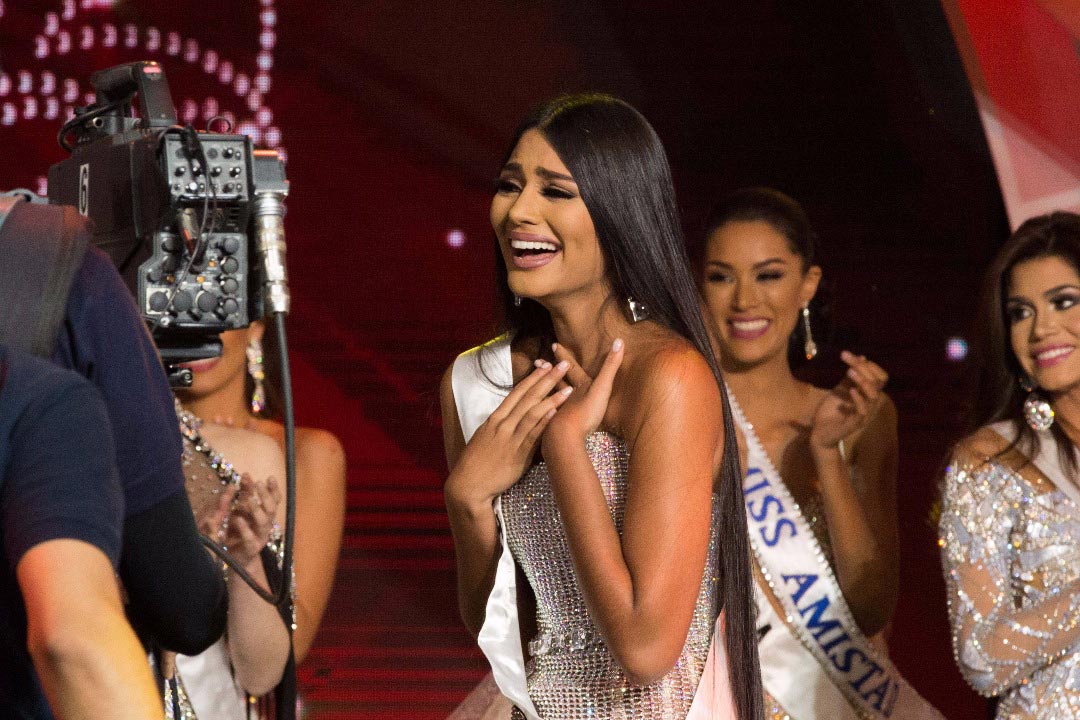 The 2017 Miss Venezuela pageant. (Photo: EFE news agency)
The 2017 Miss Venezuela pageant. (Photo: EFE news agency)
“A person who decides to participate in Miss Venezuela becomes a public figure overnight,” he says. “If they decide to pursue a modeling career, having participated in the competition allows them to charge ten times as much.”
Viviana Valente, the Miss Portuguesa of 2016, confirmed this, noting that she booked enough commercials and publicity jobs to recover her investment within a very short time.
High as that price may seem for working-class individuals, money is no object for Osmel Sousa, the beauty czar who has reigned over the pageant as president since the early 1980s. He is unreservedly lavish and imperious -- not a single feather moves unless he consents.
He has no qualms admitting that he wants and is willing to pay for perfection. A living Barbie, size 36-24-36.
“If a girl needs a nose job, you get her one. This is an industry, and as an industry we must strive for perfection. We cannot settle for mediocrity,” he said in a 2014 BBC documentary.
Not all that glitters
Sousa goes in for gowns, for example, that cost between $5,000 and $10,000, depending on the designer. But in most cases, an arrangement is made in which the contestant models a gown, displays it, and then returns it.
Other costs are less recoverable. Contestants spend around $10,000 on outfits, preferably brand names. Dolce & Gabbana, Louis Vuitton, Armani, Rayban, and Louboutin are paraded around at the Quinta, the headquarters of the the Miss Venezuela Organization in Caracas, as if it were a runway in Paris or Milan.
Natural hair extensions have become as necessary as clothing. Buying and inserting them can cost $550.
“At first, I lived with a friend in Caracas, until one of my dad’s friends let me stay at a rental apartment of his,” says Miss Bolivar 2015, Alvany Goncalves. “Every day I bought new clothes – you must always look flawless.”
She made it clear that, other than the borrowed apartment, her father covered all her other expenses.
Some girls abandon the dream when faced with the harsh reality of the price.
“When you start telling a girl about what shoes and clothes she needs to wear, that is when [they] begin to withdraw,” said Esteban Velásquez, a Miss Venezuela pageant coach. “I had 200 girls last year and when I began to tell them [what they needed], 100 withdrew. It’s difficult.”
Others fundraise in their neighborhoods or parishes. Yet others rely on saints, the businessmen and government officials who know their way around the beauty pageant ecosystem and offer financial support in exchange for company and sometimes sexual favors.
Goncalves is quick to say that anyone who accepts a deal like this will more likely than not keep it under wraps. “If they are offered something, they stay quiet. No one is out there saying ‘this person is paying and in return I’m their companion.’ That is something that people keep to themselves.”
No Pain, No Gain
Contestants spend up to $90 a month to go to gyms with personal trainers, a luxury in today’s Venezuela.
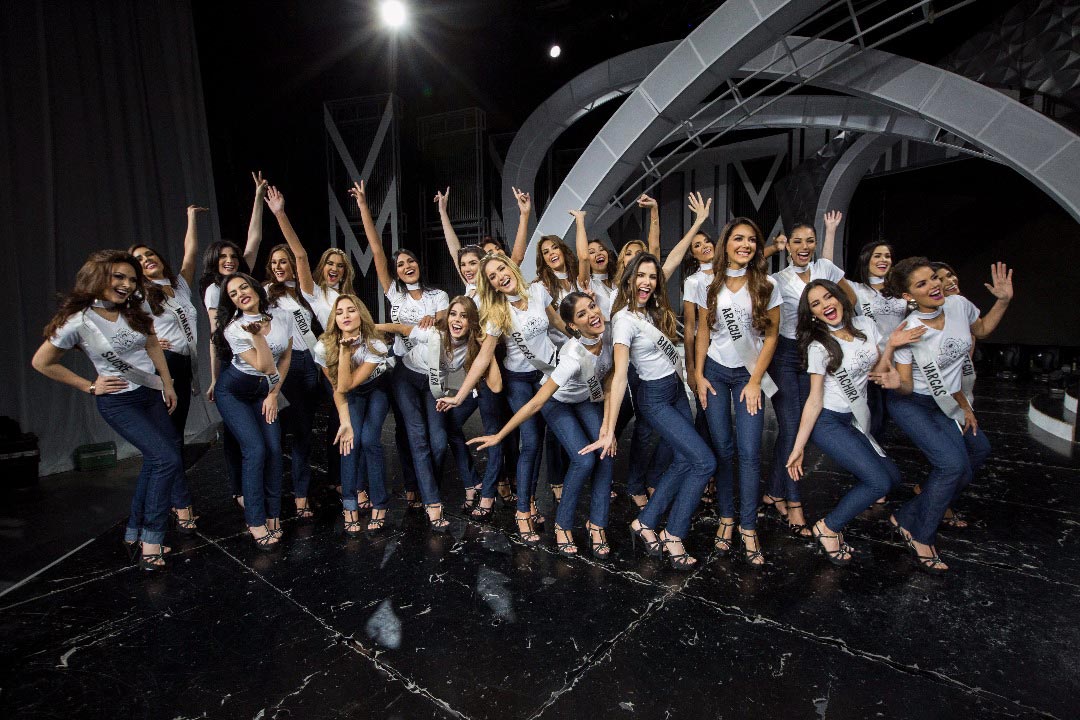 The 2017 Miss Venezuela pageant. (Photo: EFE news agency)
The 2017 Miss Venezuela pageant. (Photo: EFE news agency)
For the over 20 women chosen to compete in the pageant, the Miss Venezuela Organization arranges free gyms and pays the cost of “smile designs,” interventions where dental veneers and prosthetics make for perfect smiles.
Plastic surgery is a separate issue.
The word “thin” immediately springs to mind when describing Pina. She is 25, 5 feet 3 (1.62m), and weighs 110 pounds (50kg). She has come to Dr. Peter Romer, a renowned Miss Venezuela plastic surgeon, to find out what he can do.
In his office, a black-and-white print of Angel Falls, the world’s tallest waterfall, draws all eyes. That, and a set of buttock implants resting on the desk.
Romer compliments her body and asks her what she’d like to get done. He tries to put her at ease, telling her he doesn’t want his patients to feel self-conscious.
In response, she confesses she wants to look like Edymar Martínez, the 2014 winner.
The surgeon knows exactly what she needs. He suggests four surgeries: a rhinoplasty (nose job), a mammoplasty (boob job), ear surgery, and a liposuction to remove some fat from her hips.
No one mentions money until she leaves the private office and the secretary hands her an estimate. lt’s $13,800, not including the $50 fee for this visit. Pina earns about $60 a month as a designer. It would take her almost 20 years to finance the proposed surgeries. It is widely believed that most contestants have gone under the knife.
Sources in the pageant say that, even under these tight monetary constraints, some women can convince pageant surgeons to do the work for free if they are considered especially promising candidates.
A ‘Saint’ in the Shadows?
Five women wait for their names to be called, fidgeting in the air-conditioned lobby of the most luxurious hotel in Maracaibo, the capital of the state of Zulia, 700 kilometers west of Caracas. Outside, it’s so hot that it’s hard to breathe.
The women are eager to show casting agents that they have what it takes to become a Miss Venezuela. Asked how they would finance their participation if selected, the five answer in unison: “With sponsors.”
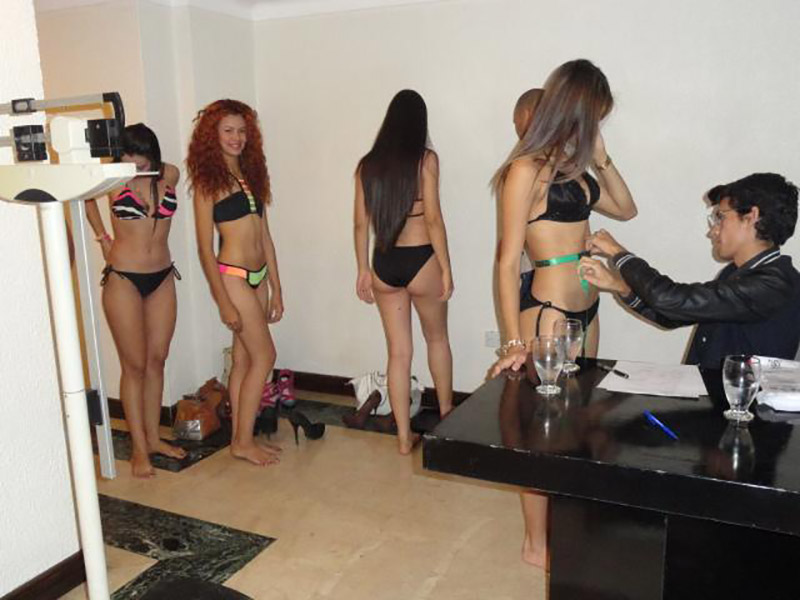 Casting for the Miss Zulia regional competition in January 2017. (Photo: Ana Griffin) Sponsors are not new. From Miss Venezuela’s beginnings, some designers lent gowns for girls to display. And even before the advent of social media, make-up artists and stylists supported participants in exchange for publicity.
Casting for the Miss Zulia regional competition in January 2017. (Photo: Ana Griffin) Sponsors are not new. From Miss Venezuela’s beginnings, some designers lent gowns for girls to display. And even before the advent of social media, make-up artists and stylists supported participants in exchange for publicity.
But in the past four years, as the country’s economy has tanked, sponsors or saints have become more prevalent. Leoncio Barrios, social psychologist and Miss Venezuela commentator, maintains that “traditionally, mattress politics is a part of the show business structure,” including Miss Venezuela. Sources say saints do not force contestants into any arrangements.
Generally, parties or dinners are organized to introduce them to potential sponsors, after which sponsors make an offer. The woman decide whether or not to accept. It’s not clear how many do, but one person familiar with the pageant estimates that one in three contestants agree to this kind of sponsorship.
To Have or Have Not
Anyely Stewart is familiar with the ins and outs of the contest. She has been working to earn a sash at the regional level for two years and is convinced that this time, she will succeed. She has met many of her competitors from all over the country and knows how dark sponsorship works.
“I have not had the opportunity for something like that to happen to me, but I do know several participants – some even winners -- and it happens frequently,” she says. “They obviously do it because they don’t have the money, they want to win, they want to look good. Afterwards I imagine that those relationships either end for good or they end in marriage. But there are some girls who get addicted.”
Stewart says she has thought many times about whether she should get involved with a saint, but has rejected the notion.“It’s all about being intelligent and clever. You can have that person as a contact and say, ‘Aww, what a nice gesture!’ But it doesn’t mean I have to go home with you just because you send me this. In my case, I would opt for playing astutely.”
On the other hand, another young woman who preferred to remain anonymous said that she refused an offer, but the man she rejected did not take it well.
“Damn you, I’m going to have you killed. I am going to make up everything I need to destroy you. Damn you, don’t even think about going out unless you want your face disfigured,” were some of the warnings that she received via text and in person.
She left the contest and the country.
Go-Betweens
Some contestants must seek support from multiple sponsors to cover all their costs. “For them, the ideal scenario is finding patronage from bankers or someone from the government, [as they] offer the best support and that way they don’t need to go out with several men. These patrons, for lack of a better word, are generally married men. It is obvious that their families are unaware of this activity, which is why everything is handled very discreetly,” the girl who received threats says.
Some saints, she says, have “established a rapport with seasoned managers. Every year they have them scout for one or several girls (young women), they introduce them and they are enveloped in such a way that they do not feel as though they are prostituting themselves.”
The topic of saints and hidden financing became more than just a rumor after Patricia Velásquez, a former Miss Venezuela who is now an actress and model, said in her 2014 autobiography No Heels, No Reservations that she had to prostitute herself to finance her participation in the 1989 Miss Venezuela.
“Very early on, I understood that in order to afford my participation in the Miss Venezuela I would have to use my gifts to find a sponsor,” she wrote. “Not everyone had to go to such lengths but, wrongfully so, I thought that was my only shot.”
She described her saint as an individual with a large face and an enormous mustache. “I did what I could to charm him, and I succeeded. He got me an apartment in Caracas and paid for anything that I needed for the pageant,”Velásquez wrote. Her encounters with her patron, who she describes as a man 15 to 20 years older with an amiable demeanor, occurred on a weekly basis.
In May 2017, three years after Velásquez’s revelation, Migbelis Castellanos (Miss Venezuela 2013), appeared in Miami in a play about the hidden side of Miss Venezuela. The play was called Anything For An Arepa, meaning one does what one has to in order to stay alive.
In her monologue, which she called autobiographical, Castellanos discussed subtle suggestions by her boss, indirectly referring to Sousa, who allegedly said that she should thank the person who provided the costly trousseau she was taking to Miss Universe.
“‘Here are the seven bags full of the clothes that you must wear during the pageant,’” she quotes her boss as saying in the monologue. “I immediately thought to myself, who paid for all of this? Because to my knowledge, the organization had only approved 300,000 bolivars which would only be enough for a jacket and a pair of pants… He promptly said to me, ‘And this is an extremely expensive purse, sent to you by a dear friend of mine who would like to meet you.’”
“I froze … then and there I saw a clear image of the dinner I was going to have to have with the alleged fan and how I would have to express my gratitude for the gift. Not a chance! I am not going to pay [in this manner] for gifts from strangers.”
Sousa denounced her allegations.
“The only man I ever sent her to was the psychiatrist, because she had quite a few loose screws. I don’t believe she ever went,” he said.
Yet Velásquez’s account rings true to a main Miss Venezuela pageant coach, Esteban Velásquez (no relation), who has been navigating the inner workings of the organization for years. He has managed several women who have participated in pageants as well as Miss International 2015, Edymar Martinez.
He concedes that hidden patronage is common, and believes it harms not just the pageant but the country. “It happens everywhere,” he said, “But I tell them – the girls – that I don’t work with whores. I know that behind all this, it will always be detrimental for them. It’s inevitable. We are living in a country where people sell themselves for soap. It’s not just happening in the Miss Venezuela, it is happening in universities and in supermarkets.”
The First Point of Contact
Regional pageants have proliferated since the first -- Miss Aragua -- was launched about 15 years ago, according to Esteban Velasquez.
Provincial pageants provide a way for girls from outside the capital to aspire to the status of Miss Venezuela.
Every regional pageant selects 5 to 10 women. Sousa and his team then pick participants for the national Miss Venezuela competition in Caracas.
Ibrahim Rivas is another manager that, like Velásquez, says he deals with participants straightforwardly. He tells contestants they they can count on him in any situation that could undermine their integrity.
“I am not going to take any of the girls to prostitute themselves,” he says.
Montaldo, the entertainment journalist and speech coach, says he “was always very clear and direct (with his students) when warning them about the risks that exist in the modeling world, especially now that Venezuela is going through a difficult situation and economic crisis.”
Ronaldo Perozo, who does makeup for Miss Venezuela contestants, says “It’s an issue that affects all Venezuelans. I’ll tell you this, if I were a woman and was 19 years old, with that height (5 feet 9 inches) and someone tells me ‘this is the Portuguese man who owns all of the refrigerator units in [the Miranda state] and he’s interested in you’, I’d sit and start negotiating.”
“When you begin to think about it, about your mother, your father, your little brother, about an education… so then, at that point, don’t come talking to me about values,” he says.
The Pope of Pulchritude
Osmel Sousa has been praised over the years for his contributions to the Miss Venezuela contest, but has come under criticism for allegedly turning contestants into merchandise.
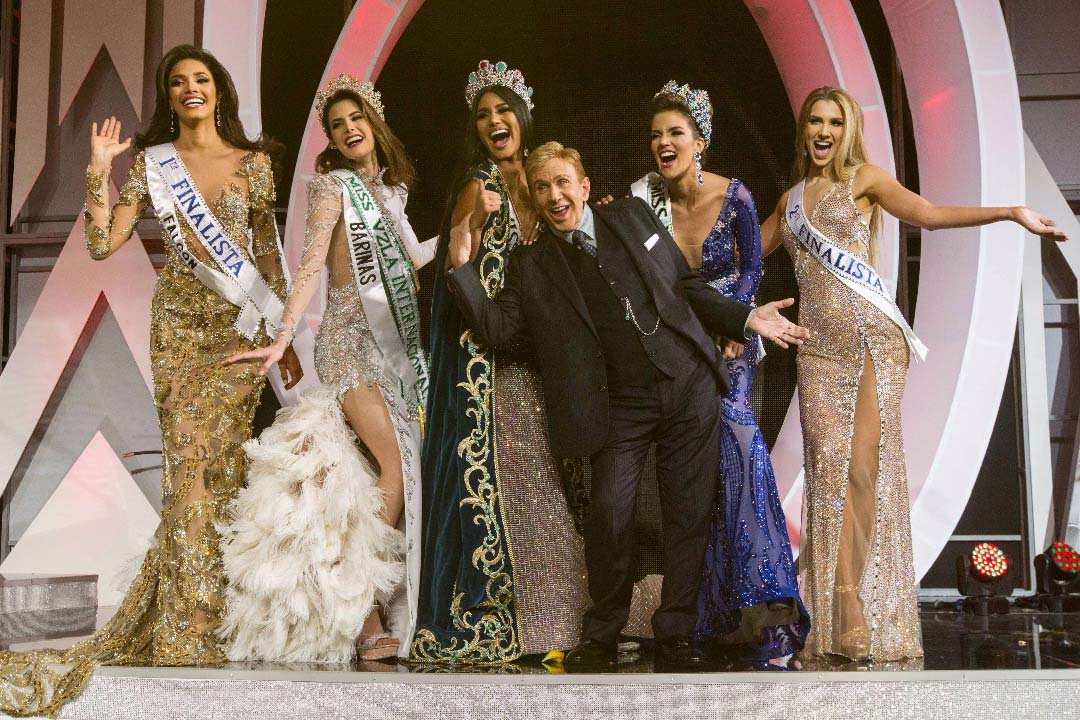 Osmel Sousa and contestants in the 2017 Miss Venezuela pageant. (Photo: EFE news agency)
Osmel Sousa and contestants in the 2017 Miss Venezuela pageant. (Photo: EFE news agency)
Cuban by birth, he has exerted control over the contest to the point of inclusion in the Guinness World Records as the person responsible for Venezuela winning two Miss Universe crowns in a row. He is also credited with seven Miss Universe crowns in total and six Miss World wins.
Everything that happens in the Miss Venezuela undergoes his scrutinizing gaze. Everything.
People who know him say the real Sousa is nothing like the rambunctious character seen on TV, harshly critiquing the bodies of aspiring contestants and shattering their self-esteem.
“No dear, you don’t have curves; what you have are mountains,” was one Sousa jibe directed at a contestant, who are generally 18 to 19 years old.
During his glory days, he was described as a professional and circumspect man, comfortable with his power to shape the lives of young aspirants.
But in 2013, Adriana Cisneros, the daughter of billionaire Gustavo Cisneros, was named chief executive officer of the parent company of the Miss Venezuela Organization, the Cisneros Group (Grupo Cisneros).
Since then, Sousa’s near-absolute control of the pageant is believed to have slipped.
“In (2016), Osmel Sousa´s candidate was Miss Distrito Capital. He wanted her to win, but it didn’t happen. Osmel used to select the judges, generally consisting of his high society friends in the past. But this (time) Venevisión selected the judges,” says Montaldo, the entertainment journalist and speech coach.
Grupo Cisneros is a conglomerate that owns businesses in a variety of industries including telecommunications, media, sports teams, real estate and beer. According to Forbes, Gustavo Cisneros has a fortune valued at $1.38 billion.
In an August 2015 edition of the Caracas-based publication La Razón, journalist Manuel Isidro Molina accused Sousa of connecting saints with contestants.
On Oct. 2, 2015, Sousa published a response on www.missvenezuela.com rejecting the “false accusations.” He said that, throughout his 40-year career, he has worked towards a single goal: “My objective in the beauty world has always been to provide participants with an integral preparation that allows them to grow and prepares them to compete successfully on the international stage.”
Meanwhile, pageant officials declined to speak to reporters about this story, citing “constraints in their agenda.” When approached a second time, there was no response.
Just a Favor Between Friends?
Some interesting alliances have arisen among Sousa’s friends, government officials, and the young competitors.
One former Miss Venezuela contestant who prefers to remain anonymous describes what happened to her one night.
She was at a family lunch at an expensive restaurant in Caracas and Osmel was sitting at a nearby table with several others, among them his assistants Ela Ávalos and Harry Levy, she recalls. “I approached them to say hello. At this table were [businessman] Antonio Chambra and [his assistant at the time] Carlos Persa. At that time, I didn’t know who they were.” After she said goodbye, she returned to her table.
 Antonio Chambra, Osmel Sousa, and Ana Carolina Ugarte (Miss Monagas 2013 and Venezuela’s candidate for Miss World 2017). (Photo: missverdadoculta) Chambra and Sousa are such close friends that the beauty impresario has become the face of the chain of stores.
Antonio Chambra, Osmel Sousa, and Ana Carolina Ugarte (Miss Monagas 2013 and Venezuela’s candidate for Miss World 2017). (Photo: missverdadoculta) Chambra and Sousa are such close friends that the beauty impresario has become the face of the chain of stores.
So she was surprised four days later to get a message from Persa, inviting her to meet his boss at his office. He also left an open-ended offer in case she might need anything related to the pageant. She thanked him, but declined.
She called Ávalos to chide her for disclosing her contact information to a stranger. She says that Avalos responded: “You are a grown woman now. You know what you are doing. … It’s up to you if you take advantage of this opportunity or not.”
Reporters contacted Avalos, but she did not respond to questions.
Chambra, 53, is a Venezuelan businessman and the president of Traki CCB Plus, C.A., a department store chain. Initially, the stores sold clothing, furniture and toys, but recently they have expanded to include food.
The power in the Crown
Sousa has other influential friends who seem to like beauty queens and the pageant world. He is frequently photographed with Octavio Maza, the alternate president of Banco Caroní.
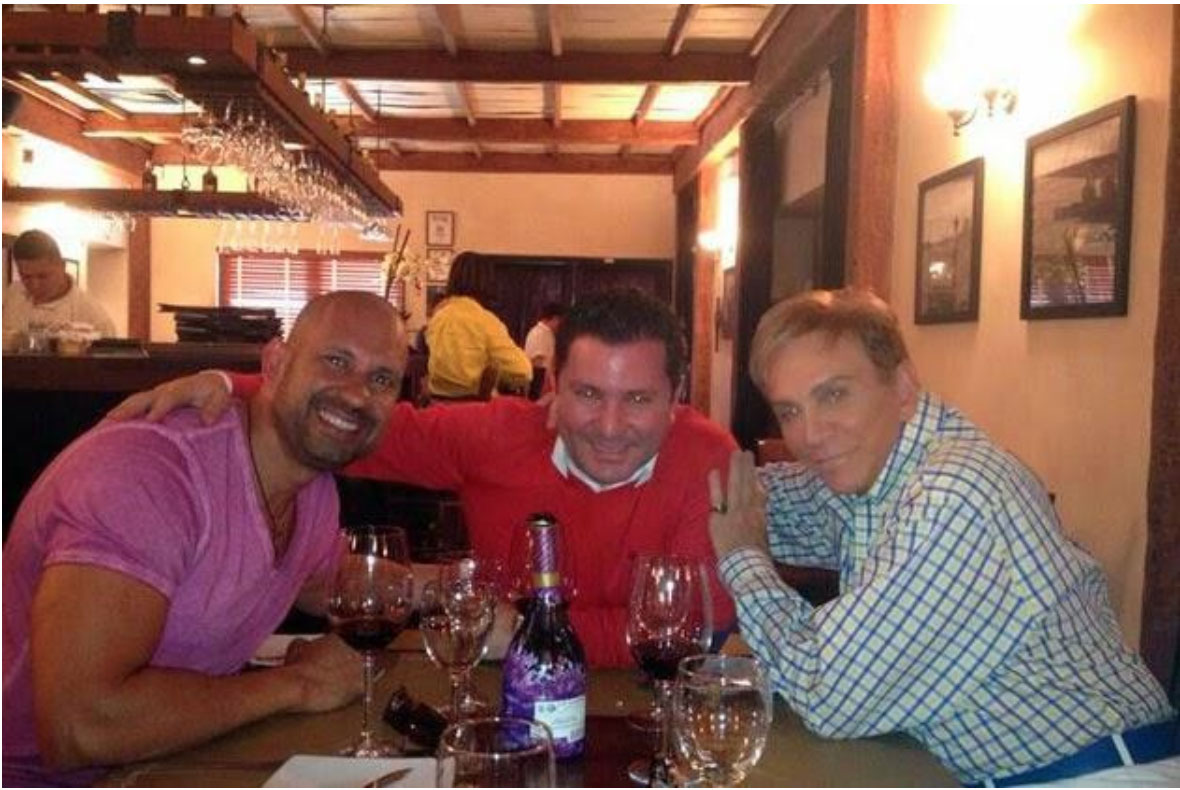 Richard Linares, a Miss coach, Octavio Maza, and Osmel Sousa. (Photo: Noticias 24 Carabobo)
Richard Linares, a Miss coach, Octavio Maza, and Osmel Sousa. (Photo: Noticias 24 Carabobo)
Maza’s Twitter feed includes other images in which he recounts his relationship with the Miss Venezuela pageant, like this photo, where he is posing with Sousa’s former assistant, Ávalos:
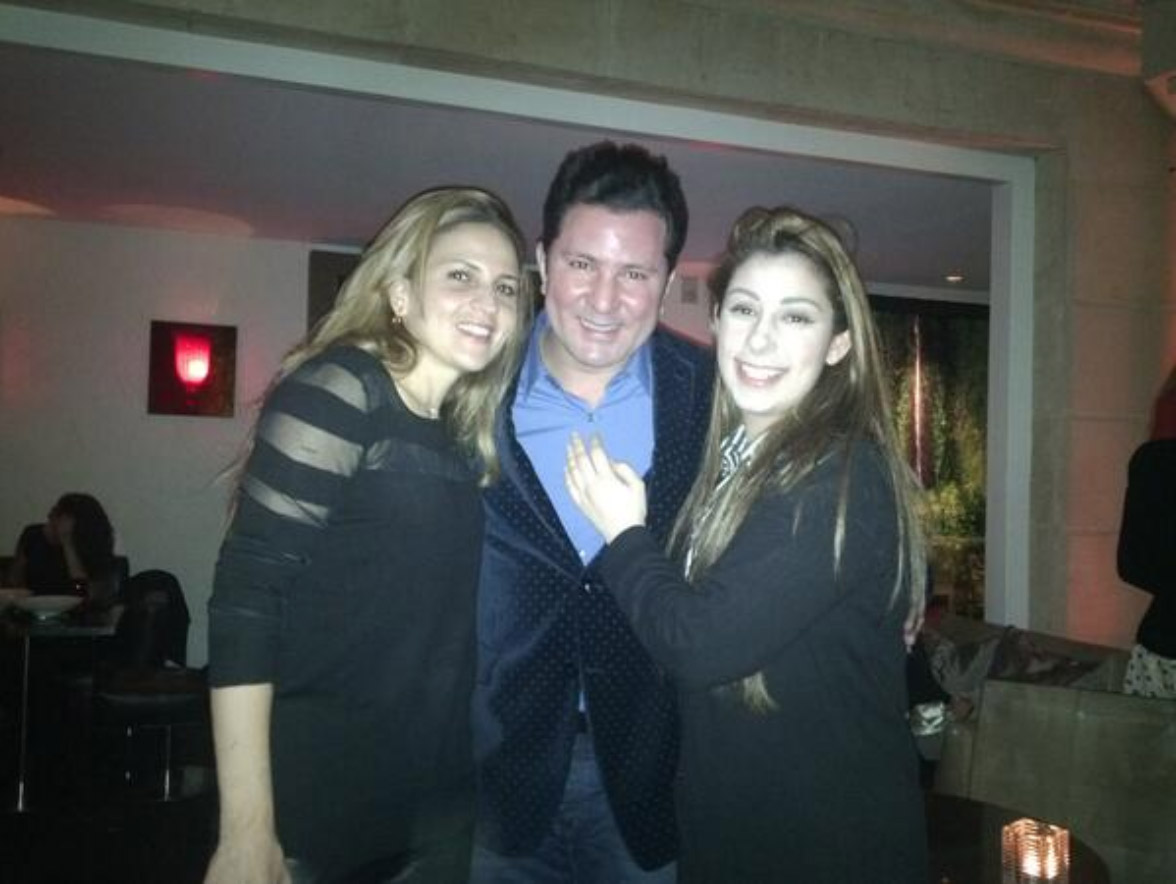 Octavio Maza (center) poses with Sousa’s former assistant, Ela Ávalos (right). (Photo: Twitter)
Octavio Maza (center) poses with Sousa’s former assistant, Ela Ávalos (right). (Photo: Twitter)
A more recent photo displays his romantic relationship with Valeria Véspoli (Miss Monagas 2015).
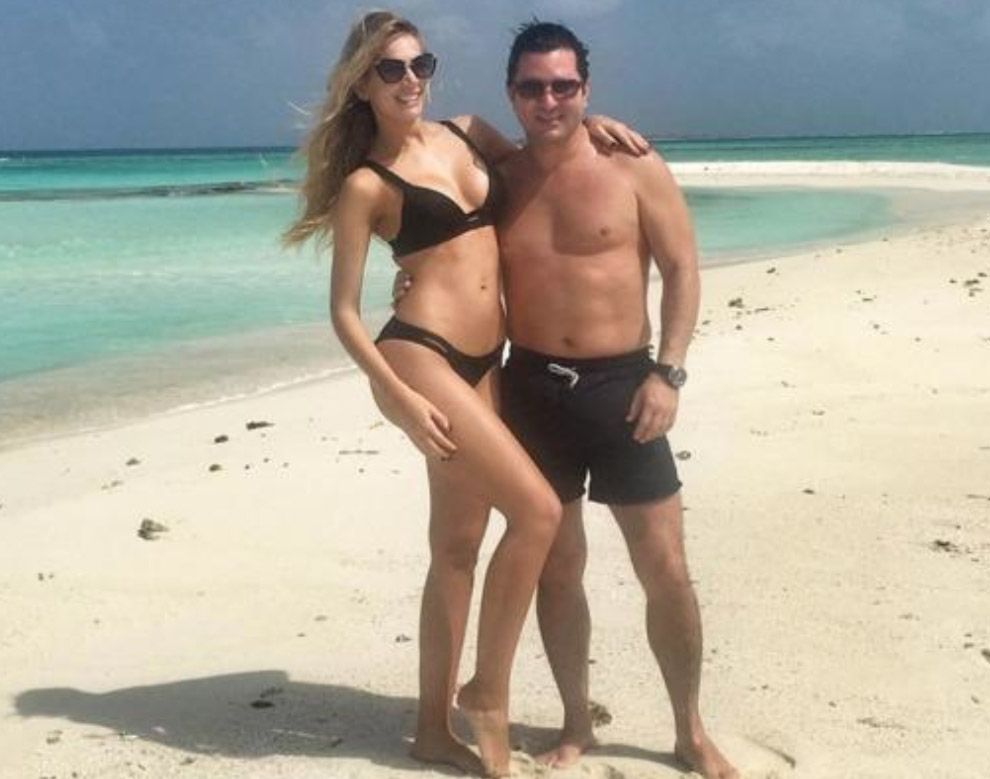 Octavio Maza poses with Valeria Véspoli (Miss Monagas 2015). (Photo: Twitter)
Octavio Maza poses with Valeria Véspoli (Miss Monagas 2015). (Photo: Twitter)
Not all relationships between powerful men and aspiring beauty queens go swimmingly. Nelson Merentes, the former president of the Venezuelan Central Bank, allegedly had a romantic relationship with a contestant in the Miss Supranational 2015 pageant -- who revealed via Instagram that her cousin had stolen money and jewelry from Merentes’ home. Merentes has been seen surrounded by Misses on multiple occasions, according to local media reports.
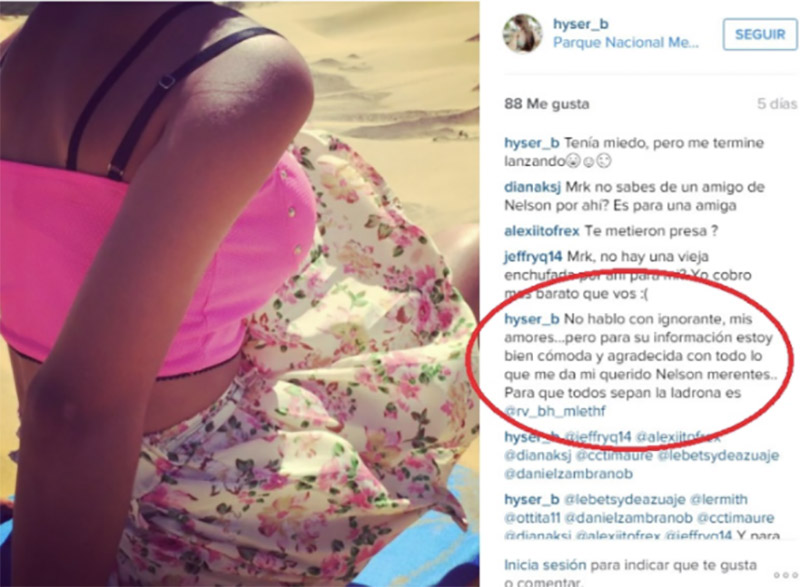 In her Instagram profile, Hyser Betancourt brags that her cousin had stolen money and jewelry from Nelson Merentes. (Photo: Instagram)
In her Instagram profile, Hyser Betancourt brags that her cousin had stolen money and jewelry from Nelson Merentes. (Photo: Instagram)
Others seem to work out well.
Carlos Mata Figueroa, 60, is a former governor of the state of Nueva Esparta. He is a general and Venezuela’s Minister of Defense between 2010 and 2012. This January, he married Alejandra Mora, 27, a former regional Miss Venezuela contestant.
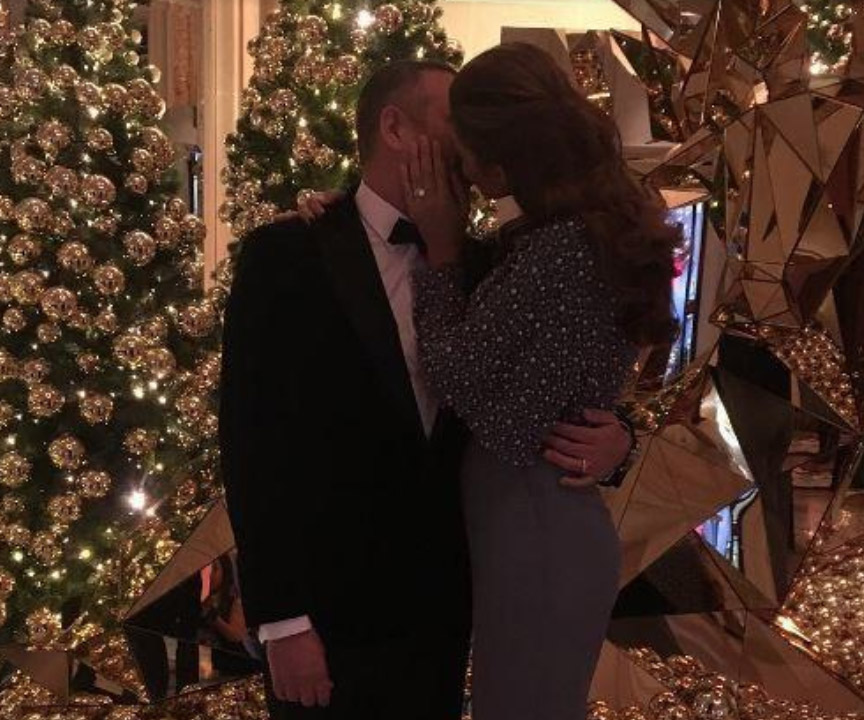 Maikel Moreno and Débora Menicucci, Paris, December 31, 2016. (Photo: Instagram) The current president of the Supreme Court of Justice, 51-year-old Maikel Moreno, married Debora Menicucci, 26, a top beauty queen, who represented Miss Venezuela in the Miss World contest in 2014.
Maikel Moreno and Débora Menicucci, Paris, December 31, 2016. (Photo: Instagram) The current president of the Supreme Court of Justice, 51-year-old Maikel Moreno, married Debora Menicucci, 26, a top beauty queen, who represented Miss Venezuela in the Miss World contest in 2014.
On Menicucci’s social media, she posted that Sousa, the Miss Venezuela kingpin, could make it as a babysitter.
Opposition politicians also seem to like beauty queens. Carlos Ocariz, mayor of the urban Sucre municipality, dates Miss Venezuela 2002, Mariángel Ruiz.
Similarly, Deputy of the National Assembly Carlos Paparoni of the the Primero Justicia party recently broke up with Miss Vargas 2016, Antonella Massaro. Diego Scharifker, a a councilman of the Chacao municipality, married Miss Cojedes 2016, Sarah Dávila, after dating for over five years.
 Osmel Sousa with Maikel Moreno and Debora Menicucci's baby. (Photo: Instagram) Until a few years ago, the Miss Venezuela world tended to stay out of politics. Since then, Sousa has been posting photos of himself with government-affiliated individuals on social media.
Osmel Sousa with Maikel Moreno and Debora Menicucci's baby. (Photo: Instagram) Until a few years ago, the Miss Venezuela world tended to stay out of politics. Since then, Sousa has been posting photos of himself with government-affiliated individuals on social media.
He has been keen to rub shoulders with the strong and mighty. For example, he expressed his support for then-candidate Donald Trump during the recent US presidential race. During a video interview recorded shortly after the election, he said:“He and his wife have always been very special to me.”
Such warm feelings were not universal. When Trump declared his candidacy for the US presidency on June 16, 2015, his comments disparaging Mexican immigrants as criminals offended a number of countries, including many Venezuelans.
Not until Trump sold the Miss Universe organization to the company WME/IMG in September 2015 did those countries embrace the pageant once again.
Sousa subsequently celebrated Trump’s victory. “We have a friendship. Of course, I don’t get into politics, neither here, nor there, but it is always nice to see a friend succeed,” he said, displaying his phone screensaver: a picture of him next to Trump.
 Osmel Sousa and Donald Trump. (Photo: Osmel Sousa)
Osmel Sousa and Donald Trump. (Photo: Osmel Sousa)
Coordination by Laura Weffer Cifuentes.
